
EAT LESS SALT
KEEP YOUR SHAKER, BUT BEWARE SNEAKY SOURCES.
MOVE OVER TRANS FAT. Ciao, carbs. Salt is having its day in the nutrition hot seat. But beyond the salt we add in the kitchen and at the table, most of us don’t know where salt lurks, nor do we know the recommended limits, or why it even matters anyway. Even the terminology muddles things up: “Salt” and “sodium” are used almost interchangeably, but salt is only 40% sodium (the rest is chloride).
Our bodies need sodium to maintain the right balance of fluids and to help with muscle movement and contraction. The problem is, we’re getting too much: The average American gets 3,400mg a day, about one and a half times more than the maximum allotted by the Dietary Guidelines for Americans. High levels of sodium can elevate blood pressure, which damages the body’s circulatory system. The challenge is that not everyone has the same sensitivity to sodium, so a direct correlation between high or low sodium in the diet and cardiovascular disease risk has been difficult to prove.
Still, national guidelines recommend adults limit their daily intake to less than 2,300mg, the equivalent of just 1 teaspoon of salt. The limit for those at risk of high blood pressure—African-Americans, people with hypertension, and anyone over the age of 51—was lowered to 1,500mg.
Your goal for this chapter is to become salt-aware—to prudently monitor and reduce your intake even if you’re not hypertensive, and to actively reduce it if you are. You’ll find guidance about sneaky sources of sodium and how to use spices and other low-sodium ingredients for maximum flavor.
YOUR GOAL
Reduce the amount of sodium you eat every day.
The 12 Healthy Habits

NEARLY 80% OF THE SODIUM WE CONSUME comes from restaurant meals and packaged foods. You can significantly slash that by focusing on fresh, unprocessed foods that you can make easily at home, like these six:

SALTY ADD-ONS
You may not realize just how easily sodium can sneak into your meal. Keep an eye out for these culprits:
1 beef bouillon cube  900mg
900mg
2 ounces deli ham  600mg
600mg
2 tablespoons barbecue sauce  450mg
450mg
1 pickle spear  320mg
320mg
1 tablespoon steak sauce  280mg
280mg
2 tablespoons sauerkraut  180mg
180mg
1 teaspoon capers  105mg
105mg
1. SALAD DRESSING
Just two tablespoons of some prepared dressings add 500mg of sodium to your otherwise healthy salad.
2. TOMATO SAUCE
Almost any tomato that isn’t fresh (like jarred pasta sauce, salsa, and canned tomatoes) is soaked with sodium. Try making Basic Marinara sauce , which has 270mg of sodium per serving, compared to 500mg or more in jarred versions. The recipes for Pico de Gallo and Tomatillo-Lime Salsa have half the sodium of typical store-bought salsas.
3. PICKLES
Store-bought pickles are sodium bombs. Six bread-and-butter slices can have almost 200mg sodium, whereas a quarter-cup of Easy Refrigerator Pickles has only 64mg.
4. NUT BUTTER
An average 2-tablespoon serving of nut butter can have as many as 125mg of sodium. Get into the habit of buying a no-salt-added nut butter or break out the food processor and make your own.
5. FROZEN MEALS
Dedicate an hour every week to cook one freezable meal, and you’ll get huge payoffs. Baked Vegetable Lasagna, for example, has only 543mg of sodium compared to the more than 700mg found in many store-bought frozen lasagna meals. Really don’t have time to cook? Cut the sodium of takeout or frozen family meals by adding equal amounts of fresh steamed vegetables.
6. CANNED SOUPS
Yes, they’re convenient, but many are also loaded with added salt. Soups are ideal make-ahead meals, and you can save yourself and your family hundreds of milligrams of sodium (and money, too).
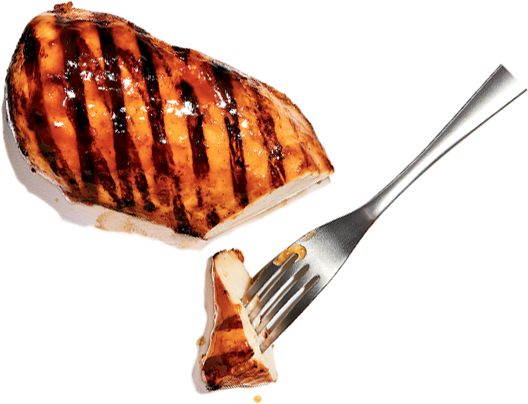
FORGO STORE-BOUGHT SAUCES to pair with your meals in favor of easy-to-make at-home versions that slash sodium for ideas.
Many foods we consider healthy contain a not-so-healthy dose of sodium. Here, three surprising offenders:
▪ Whole-wheat bread Some have as much as 400mg per slice—which means you’re getting 800mg in your sandwich without even adding in your sodium-heavy lunchmeat. Look for a brand that provides less than 170mg per slice of bread.
▪ Breakfast cereal You probably carefully check the cereal’s food label for calories, fiber, and sugar, but some brands also pack 170 to 280mg of sodium per serving. Look for lower-sodium options. Shredded wheat brands and plain oatmeal fit the bill.
▪ Cottage cheese With an average of 400mg sodium per ½-cup serving, it can change a healthy dish into a high-sodium one. Choose no-salt-added cottage cheese for just 60mg sodium per serving.
 What tricks have you found for cutting back on salt?
What tricks have you found for cutting back on salt?
“My motto is steering clear of the drive thru. I make a lot of Mexican food at home, and make my own seasonings, rather than buying ‘taco seasoning’ for example; that way, I control the sodium.”
—Aimee Jackson Fortney
“Instead of buying premade seasoning mixes (which contain mostly salt) I started making my own: taco seasoning, Italian seasoning, chili seasoning, etc. Now I can have all the flavor with virtually no salt!”
—Chris O’Malley
FRUITS AND VEGGIES are naturally low in sodium and high in potassium, a mighty mineral that helps counter sodium’s effect on blood pressure. Here, six ways to help you get more of this super substance:
REACH FOR THE STARS.
Oranges, bananas, potatoes, tomatoes, dried apricots, melon, and kidney beans all have the highest levels of potassium, so aim to include at least a couple of them in meals and snacks every day.
MAKE YOUR OWN CONDIMENTS.
Try replacing ketchup, which has 190mg of sodium per tablespoon, with a fresh homemade salsa. Chop roasted bell peppers, drizzle with olive oil, and sprinkle with black pepper, and use as a flavorful relish for burgers, chicken, or fish.
KEEP THE CONVENIENCE.
It’s not necessary to give up all convenience products to keep sodium levels in check. Most plain frozen vegetables are salt-free. Ditto for dried beans, chickpeas, and vegetables canned without salt. You can also cut sodium by 40% by simply rinsing canned beans.
EAT SEASONALLY.
Rely on the season’s freshest produce for more flavor satisfaction. Because the produce is fresh, the flavor will be at its best.
SPICE IT RIGHT.
Instead of frozen French fries doused with salt, try baked potato wedges finished with fresh sage or thyme or a toasted nut oil.
SPLASH IT UP.
Roasting carrots, eggplant, tomatoes, or any vegetable with a splash of olive oil and a grind of fresh pepper can result in rich-flavored side dishes that don’t need salt.
THE POWER OF POTASSIUM
This mineral helps lower risk of high blood pressure and possibly even stroke. So don’t just focus on ways to cut sodium; look for ways you can increase potassium in your diet. Few of us get the recommended 4,700mg every day.
10 Big-Time Potassium Players
1 small baked potato, flesh and skin  738mg
738mg
½ cup white beans, canned  595mg
595mg
8 ounces plain fat-free yogurt  579mg
579mg
1 medium sweet potato, baked in skin  542mg
542mg
1 cup fresh orange juice  496mg
496mg
3 ounces halibut, cooked  490mg
490mg
1 medium banana  422mg
422mg
1 cup fat-free milk  382mg
382mg
3 ounces pork loin, roasted  371mg
371mg
½ cup cooked lentils  365mg
365mg
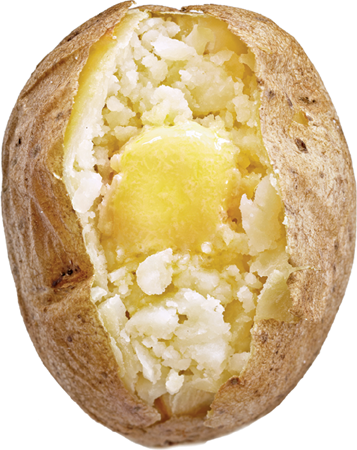
Potatoes offer a powerful punch of potassium.
with ALLISON FISHMAN

LESS SALT DOESN’T MEAN LESS FLAVOR

There are loads of ways to reduce your reliance on salt without sacrificing flavor.
▪ Make your own spice blends instead of buying premade seasoning mixes, which are often laced with salt. When you amp up the flavor with robust spices (such as cumin, cayenne, and curry powder), you’ll find that you need less salt.
▪ Put a bowl of cut lemons and limes on the table. Instead of salting your vegetables, salads, and fish, add a perky hit of something acidic.
▪ Let fresh herbs lend a helping hand. Basil pesto, chimichurri, and other herb sauces can brighten up a dish without a lot of salt. You’ll find that a little goes far, whether you’re tossing your pasta in pesto or using chimichurri sauce with your seared skirt steak. Plus, herb sauces are a great way to use up those big bunches of herbs, and they’ll keep for a week in your fridge.
▪ Adjust your salt attitude. Instead of making salt a source of guilt, turn it into a pleasure. Skip the salting during cooking and save it for the table where you can salt with style. Buy a decorative salt cellar for kosher or sea salt and gracefully spoon or pinch it onto your plate. You’ll likely use less and enjoy it more.
It’s a scientific fact that salt is an acquired taste—the more you eat, the more you get used to it. But you can turn the tables by gradually cutting back: Every two weeks, measure out all the salt called for in a recipe, put 25% of it back, and cook with the remaining 75%. Your palate will adjust.
WHEN FOOD COMPANIES make sodium claims, they have to follow labeling rules. That’s where it gets tricky. Here’s our guide:
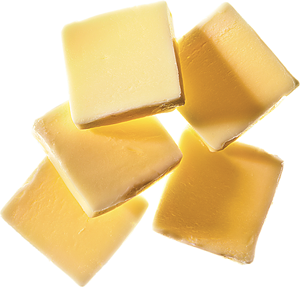
“NO SALT ADDED” OR “UNSALTED”
No salt is added during processing. This does not always mean sodium-free; some foods contain sodium naturally.
For example:
Land O’ Lakes Unsalted Butter (0mg)
vs.
Land O’ Lakes Salted Butter (95mg)
Sodium savings: 95mg per tablespoon
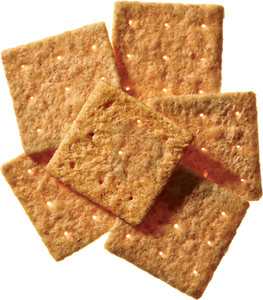
“LOW SODIUM”
This is the most stringent reduced-sodium label. Each food can have only 140mg or less sodium (natural or added) per serving.
For example:
Nabisco Wheat Thins Hint of Salt (60mg)
vs.
Nabisco Original Wheat Thins (230mg)
Sodium savings: 170mg per 16 crackers

“REDUCED SODIUM” OR “LESS SODIUM”
Must contain at least 25% less than the original food, a competitor’s product, or another reference.
For example:
Kikkoman Less Sodium Soy Sauce (575mg)
vs.
Kikkoman Soy Sauce (920mg)
Sodium savings: 345mg per tablespoon

“LIGHT IN SODIUM” OR “LIGHTLY SALTED”
Must contain 50% less than the original food, a competitor’s product, or another reference.
For example:
Lay’s Lightly Salted Potato Chips (85mg)
vs.
Lay’s Classic Potato Chips (180mg)
Sodium savings: 95mg per ounce

“I have a healthy diet, but my blood pressure is still higher than I would like.”
MARY IHLA
Web Designer
 SALT CHALLENGE: Mary misses salt—a hankering that dates back to childhood. “I crave it. When other kids were buying candy bars, I was buying sunflower seeds,” she says. However, Mary fears that recently losing 50 pounds has only compounded the sodium problem. “I have noticed that when products are low in fat, they’re high in sodium. They put sodium in to add flavor.”
SALT CHALLENGE: Mary misses salt—a hankering that dates back to childhood. “I crave it. When other kids were buying candy bars, I was buying sunflower seeds,” she says. However, Mary fears that recently losing 50 pounds has only compounded the sodium problem. “I have noticed that when products are low in fat, they’re high in sodium. They put sodium in to add flavor.”
OUR ADVICE
▪ Low fat can mean more salt. Mary caught on to a trick of some low-and no-fat foods: swapping salt (or sugar) for missing fat. Reduced-fat and fat-free sour cream have twice the sodium of regular, but with half the calories and fat. Be a label reader!
▪ Watch for salty soups. Canned soup is often very salty, so start making your own (freeze extra for busy nights). But know that store-bought broths can be high in sodium. Use reduced-sodium versions—it’s an easy switch. Our Turkey and Bean Chili, which uses lower-sodium chicken broth, has only 474mg sodium per serving—half the amount of some canned soups.
▪ Identify one salty component. When using a high-sodium food (like a store-bought marinade), make the other parts of the meal low-sodium, like opting to dip your bread in olive oil instead of a salty garlic-butter spread.
▪ Focus on other flavors. Glaze chicken breasts with sweet apricot preserves, top grilled meats with carmelized onions, serve Beef Tenderloin with Horseradish Chive Sauce, or Roast Pork Tenderloin with Plum Barbecue Sauce.

Use lower-sodium broths and stocks in soups and stews, like Turkey and Bean Chili.
PARENTS NEED TO WATCH THE AMOUNT of sodium their kids are taking in—kids have lower calorie needs, which means they also need less sodium. The daily sodium intake limit for children 1 to 3 is 1,000mg; 1,200mg for kids 4 to 8; and 1,500mg to 2,300mg per day for adolescents and adults up to age 51.
Kids need lunches for school on average 180 times a year. These lunch ideas are a few options built around some core preferences.
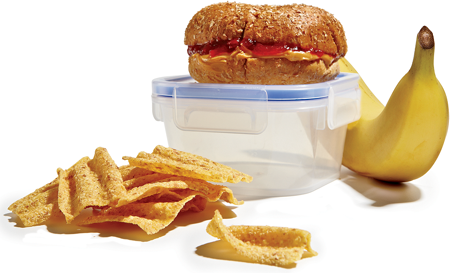
▪ Whole-Wheat PB&J
1 tablespoon peanut butter, 2 teaspoons jam on 1 mini whole-wheat bagel + 1 oz. whole-grain chips (about 16) + 1 small banana
413mg sodium
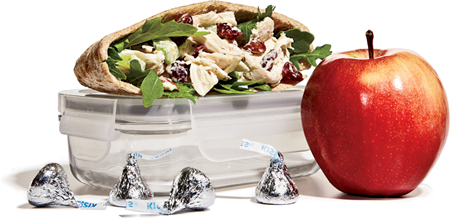
▪ Chicken Salad
½ cup Herbed Chicken Salad with 1 tablespoon sweetened dried cranberries and ½ cup mixed greens in half a 6-inch whole-wheat pita + 1 medium apple + 4 milk chocolate kisses
381mg sodium

▪ Beefy Sandwich
2 oz. lower-sodium roast beef, lettuce, 2 slices tomato, ½ oz. slice white cheddar, 2 teaspoons light mayo on whole-grain bread + 2 pineapple and strawberry fruit kebabs + ½ oz. unsalted peanuts
508mg sodium

▪ For the Rabbits
Mixed greens, 2 oz. rotisserie chicken, 1 tablespoon sliced almonds, ¼ cup chopped tomatoes, 1 hard-cooked egg, 2 tablespoons oil-and-vinegar dressing + 2 cups 94%-fat-free popcorn + 1 orange, peeled
460mg sodium

“When it comes to salt, I really haven’t paid attention at all.”
BLAKE KOHN
Preschool Director
 SALT CHALLENGE: Blake loves to cook and takes great joy in the fact that she provides a homemade dinner almost every night for her husband and two young children. She pays attention to fat and calories when she cooks, but she’s not sure how salt fits into the health equation.
SALT CHALLENGE: Blake loves to cook and takes great joy in the fact that she provides a homemade dinner almost every night for her husband and two young children. She pays attention to fat and calories when she cooks, but she’s not sure how salt fits into the health equation.
OUR ADVICE
▪ Pare down the packages. Building meals and snacks around fruits and vegetables, whole grains, and lean, unprocessed meats will help keep sodium levels in check. The saltiness sneaks in with those snack bags of crackers and chips, hot dogs, cold cuts, canned foods, frozen pizzas, and packaged meats.
▪ Pick a smarter salt. Because of its larger crystal size, a teaspoon of kosher salt contains almost 25% less sodium than a teaspoon of table salt. You can use the same amount when cooking and automatically reduce your intake by about a quarter.
▪ Rinse canned foods. Draining and rinsing may wash away more than a quarter of the sodium. In one study, adding this step cut more than 40% of the sodium from canned beans.
▪ Add salt in stages. Start with less, then slowly add it throughout the cooking process, tasting as you go. You may end up not needing all the salt the recipe suggests.


Ditch the salty spreads and dip bread in olive oil mixed with your favorite herbs and spices. It’s low in sodium and high in heart-healthy fats.
YOU CAN FIND AN ASTOUNDING array of sauces and salad dressings at the grocery store these days, but these products often have a hefty dose of sodium lurking inside. The following flavor enhancers are easy to prepare with just a touch of salt and a ton of taste:
Sicilian Pesto
¼ cup pine nuts
3 garlic cloves
4 cups loosely packed basil leaves (about 2 ounces)
¼ cup extra-virgin olive oil
½ teaspoon kosher salt
¼ teaspoon freshly ground black pepper
⅛ teaspoon crushed red pepper
½ cup (2 ounces) grated fresh Parmigiano-Reggiano cheese
2 cups chopped seeded tomato, drained (about 2 large)
1. Heat a small skillet over medium heat. Add nuts to pan; cook 4 minutes or until lightly toasted, stirring constantly. Remove from pan.
2. Place nuts and garlic in a food processor; process until minced. Add basil, oil, salt, and peppers; process until blended, scraping sides occasionally. Add cheese; process until smooth. Spoon into a bowl; fold in tomato. Serves 20 (serving size: 2 tablespoons).
CALORIES 51; FAT 4.6g (sat 0.8g, mono 2.7g, poly 0.9g); PROTEIN 1.4g; CARB 1.5g; FIBER 0.6g; CHOL 1mg; IRON 0.4mg; SODIUM 82mg; CALC 41mg

1 ½ cups finely chopped red onion
½ cup red wine vinegar
¼ cup chopped fresh oregano
2 tablespoons extra-virgin olive oil
1 teaspoon crushed red pepper
½ teaspoon kosher salt
2 garlic cloves, minced
3 tablespoons chopped fresh cilantro
1. Combine first 7 ingredients in a small bowl; let stand 30 minutes. Stir in cilantro. Serves 12 (serving size: about 11⁄2 tablespoons).
CALORIES 32; FAT 2.3g (sat 0.3g, mono 0g, poly 0g); PROTEIN 0g; CARB 0g; FIBER 0g; CHOL 0mg; IRON 0mg; SODIUM 82mg; CALC 0mg
Aromatic herbs and seasonings like fresh oregano, garlic, and ginger add flavor to a dish without adding any additional sodium to the meal. Dried herbs work, too.
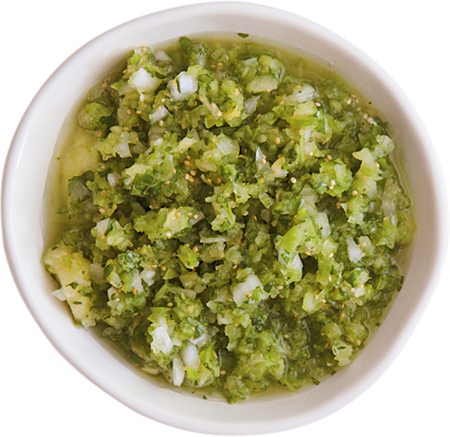
1 pound tomatillos
2 to 3 tablespoons fresh lime juice (about 1 lime)
1 jalapeño pepper, seeded and minced
½ cup chopped onion
½ cup chopped fresh cilantro
1 teaspoon kosher salt
1. Discard husks and stems from tomatillos. Place tomatillos, lime juice, and pepper in a food processor; pulse until tomatillos are coarsely chopped. Add onion, cilantro, and salt; pulse until combined. Serves 16 (serving size: 2 tablespoons).
CALORIES 12; FAT 0.3g (sat 0g, mono 0.1g, poly 0.1g); PROTEIN 0.4g; CARB 2.5g; FIBER 0.7g; CHOL 0mg; IRON 0.2mg; SODIUM 118mg; CALC 4mg
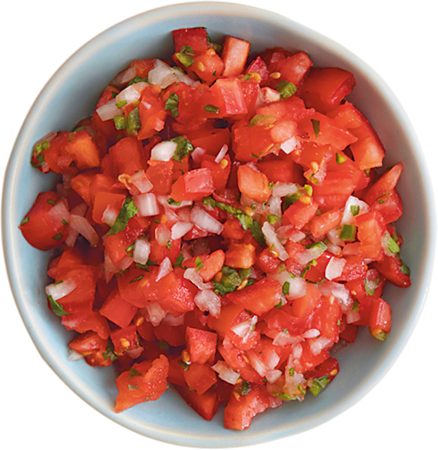
2 ½ cups chopped seeded plum tomato (about 6 medium)
⅔ cup finely chopped onion
2 tablespoons chopped fresh cilantro
2 tablespoons finely chopped jalapeño pepper (1 large)
2 tablespoons fresh lime juice
½ teaspoon salt
½ teaspoon garlic powder
1. Combine all ingredients in a serving bowl; toss well. Let stand 30 minutes before serving. Serves 14 (serving size: ¼ cup).
CALORIES 8; FAT 0.1g (sat 0g, mono 0g, poly 0g); PROTEIN 0.3g; CARB 1.8g; FIBER 0.4g; CHOL 0mg; IRON 0.1mg; SODIUM 86mg; CALC 4mg

1 cup no-salt-added ketchup
1 cup brewed coffee
2 tablespoons dark brown sugar
1 teaspoon onion powder
1 teaspoon garlic powder
1 teaspoon chili powder
1 ½ tablespoons balsamic vinegar
1 ½ teaspoons black pepper
1 ½ teaspoons lower-sodium soy sauce
1. Combine first 6 ingredients in a small saucepan; bring to a boil. Reduce heat; simmer 10 minutes or until slightly thick stirring occasionally. Remove from heat; stir in vinegar, pepper, and soy sauce. Serves 12 (serving size: about 21⁄2 tablespoons).
CALORIES 47; FAT 0g (sat 0g, mono 0g, poly 0g); PROTEIN 0g; CARB 0g; FIBER 0g; CHOL 0mg; IRON 0mg; SODIUM 24mg; CALC 0mg

Create Your Own Convenience Foods
SOMETIMES IT’S THOSE little convenience items that can dramatically hike up the sodium in a meal. Look for lower-sodium versions of your favorite pantry staples and try your hand at making your own.
Basic Marinara

3 tablespoons olive oil
3 cups chopped yellow onion (about 3 medium)
1 tablespoon sugar
3 tablespoons minced garlic (about 6 cloves)
2 teaspoons salt
2 teaspoons dried basil
1 ½ teaspoons dried oregano
1 teaspoon dried thyme
1 teaspoon freshly ground black pepper
½ teaspoon fennel seeds, crushed
2 tablespoons balsamic vinegar
2 cups fat-free, lower-sodium chicken broth
3 (28-ounce) cans no-salt-added crushed tomatoes, undrained
1. Heat a large Dutch oven over medium heat. Add oil to pan; swirl to coat. Add onion; cook 4 minutes, stirring frequently. Add sugar and next 7 ingredients; cook 1 minute, stirring constantly. Stir in vinegar; cook 30 seconds. Add broth and tomatoes; bring to a simmer. Cook over low heat 55 minutes or until sauce thickens, stirring occasionally. Serves 24 (serving size: about ½ cup).
CALORIES 50; FAT 1.8g (sat 0.2g, mono 1.3g, poly 0.2g); PROTEIN 1.3g; CARB 8g; FIBER 2.1g; CHOL 0mg; IRON 0.5mg; SODIUM 270mg; CALC 28mg
MARINARA BASICS
To store in the freezer: Ladle room-temperature or chilled sauce into plastic containers or zip-top plastic bags. Seal and freeze for up to four months. Consider freezing the sauce in 1-cup increments (two servings’ worth). That way, you can pull out exactly as much as you want for future meals.
To thaw sauce, try one of three methods:
1. Thaw in the refrigerator overnight.
2. Place frozen blocks in a saucepan. Cover and bring to a low simmer over medium heat, stirring occasionally.
3. Place frozen blocks in a microwave-safe bowl. Cover and microwave at HIGH 1 minute at a time, stirring after each increment, until thawed.
To boost taste: Long stints in the freezer can dull the taste of tomatoes. To perk up thawed sauce, add ½ teaspoon finely grated lemon rind or 1 teaspoon balsamic vinegar while reheating.
7 pounds chicken wings
Cooking spray
3 cups coarsely chopped onion
2 ½ cups coarsely chopped celery
2 ¼ cups coarsely chopped carrot
1 tablespoon olive oil
5 quarts plus 1 cup water, divided
15 parsley sprigs
15 black peppercorns
8 thyme sprigs
3 bay leaves
1. Preheat oven to 450°.
2. Arrange chicken in a single layer on a jelly-roll pan coated with cooking spray. Combine onion and next 3 ingredients in a bowl; toss well to coat vegetables. Arrange vegetable mixture in a single layer on another jelly-roll pan coated with cooking spray. Roast chicken and vegetables at 450° for 1 hour and 20 minutes or until browned, turning occasionally.
3. Place wings and vegetables in a stockpot. Pour ½ cup water into each baking sheet, scraping to loosen browned bits. Pour water mixture into pot. Add remaining 5 quarts water and remaining ingredients to pot. Place pot over medium-high heat. Bring to a boil. Reduce heat to low, and simmer 4 hours, skimming off and discarding foam as needed. Strain stock through a fine sieve into a large bowl; discard solids. Cool stock to room temperature. Cover and refrigerate 5 hours or overnight. Skim solidified fat from surface; discard fat. Serves 24 (serving size: ½ cup).
CALORIES 25; FAT 1.4g (sat 0.3g, mono 0.7g, poly 0.3g); PROTEIN 2.6g; CARB 0.3g; FIBER 0.1g; CHOL 11mg; IRON 0.2mg; SODIUM 13mg; CALC 4mg
Easy Refrigerator Pickles

6 cups thinly sliced pickling cucumbers (about 2 pounds)
2 cups thinly sliced onion
1 ½ cups white vinegar
¾ cup sugar
¾ teaspoon salt
½ teaspoon mustard seeds
½ teaspoon celery seeds
½ teaspoon ground turmeric
½ teaspoon crushed red pepper
¼ teaspoon freshly ground black pepper
4 garlic cloves, thinly sliced
1. Place 3 cups cucumber in a medium glass bowl; top with 1 cup onion. Repeat layers with remaining 3 cups cucumber and remaining 1 cup onion.
2. Combine vinegar and remaining ingredients in a small saucepan; stir well. Bring to a boil; cook 1 minute. Pour over cucumber mixture; let cool. Cover and chill at least 4 days. Serves 28 (serving size: ¼ cup).
Note: Pickles may be stored in the refrigerator for up to one month.
CALORIES 28; FAT 0.1g (sat 0g, mono 0g, poly 0.1g); PROTEIN 0.3g; CARB 7g; FIBER 0.3g; CHOL 0mg; IRON 0.1mg; SODIUM 64mg; CALC 7mg
When you buy cans or cartons of chicken broth, be sure to look for lower-sodium versions. Some regular chicken broth contains 900mg per cup.

LOOK FOR REDUCED-SODIUM VERSIONS of canned soup, or start making your own (and freeze for busy nights). The sodium savings can be immense.
Turkey and Bean Chili

This chili is ready in just 20 minutes for a quick one-pot supper.
1 cup prechopped red onion
⅓ cup chopped seeded poblano pepper (about 1)
1 teaspoon bottled minced garlic
1 ¼ pounds ground turkey
1 tablespoon chili powder
2 tablespoons tomato paste
2 teaspoons dried oregano
1 teaspoon ground cumin
¼ teaspoon salt
¼ teaspoon black pepper
1 (19-ounce) can cannellini beans, rinsed and drained
1 (14.5-ounce) can diced tomatoes, undrained
1 (14-ounce) can fat-free, lower-sodium chicken broth
½ cup chopped fresh cilantro
6 lime wedges
1. Heat a large saucepan over medium heat. Add first 4 ingredients; cook 6 minutes or until turkey is done, stirring to crumble. Stir in chili powder and next 8 ingredients; bring to a boil. Reduce heat; simmer 10 minutes. Stir in cilantro. Serve with lime wedges. Serves 6 (serving size: about 1 cup chili and 1 lime wedge).
CALORIES 211; FAT 6.5g (sat 1.7g, mono 1.9g, poly 1.6g); PROTEIN 22.5g; CARB 16.4g; FIBER 4.7g; CHOL 54mg; IRON 3.4mg; SODIUM 474mg; CALC 52mg

1 tablespoon butter
1 cup chopped onion (1 medium)
¾ cup shredded carrot
1 tablespoon minced garlic
1 tablespoon minced shallots
1 teaspoon sugar
¼ teaspoon freshly ground black pepper
⅛ teaspoon salt
10 large basil leaves, divided
3 drained sun-dried tomato halves, packed in oil with herbs
2 (14.5-ounce) cans organic diced tomatoes, undrained
1 (14-ounce) can fat-free, lower-sodium chicken broth
1. Melt butter in a large saucepan over medium heat. Add chopped onion, shredded carrot, garlic, and shallots to pan, and cook 5 minutes or until vegetables are tender, stirring frequently. Add sugar, pepper, salt, and 4 basil leaves, and cook 5 minutes. Add sun-dried tomatoes, diced tomatoes, and broth, and bring to a boil. Reduce heat, and simmer 1 hour. Remove from heat. Place half of soup in a blender. Remove center piece of blender lid (to allow steam to escape); secure blender lid on blender. Place a clean towel over opening in blender lid (to avoid splatters). Blend until smooth. Pour into a large bowl. Repeat procedure with remaining soup. Divide soup evenly among 6 bowls. Garnish each serving with 1 basil leaf. Serves 6 (serving size: ¾ cup).
CALORIES 76; FAT 2.5g (sat 1.3g, mono 0.7g, poly 0.1g); PROTEIN 2.2g; CARB 9.4g; FIBER 2g; CHOL 5mg; IRON 1.1mg; SODIUM 229mg; CALC 14mg
DRAIN AND RINSE CANNED FOODS
By simply draining and rinsing canned foods, you can cut a significant chunk of sodium. Consider this: A 15-ounce can of chili beans contains 1,570mg sodium. Draining the beans can reduce the sodium count by about 40%. The combination of draining and rinsing reduces sodium by another 5%. That shaves off about 644mg sodium—almost 30% of your daily allowance.
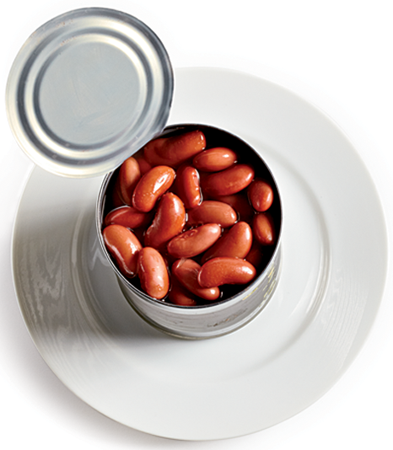
Undrained: 1,570mg sodium

Rinsed and drained: 926mg sodium
PREPACKAGED SNACKS CAN BE serious sodium offenders, especially salted nuts, microwave or prepopped popcorn, pretzels, crackers, and chips. We’ve got some tasty solutions that satisfy the craving with a lot less salt.
Sweet Chipotle Snack Mix

¼ cup sugar
1 teaspoon salt
1 teaspoon ground chipotle chile pepper
½ teaspoon ground cumin
½ teaspoon dried oregano
½ teaspoon chili powder
1 large egg white
1 cup slivered almonds
1 cup unsalted cashews
1 cup unsalted pumpkinseed kernels
1. Preheat oven to 325°.
2. Combine first 6 ingredients in a small bowl; stir with a whisk.
3. Place egg white in a bowl; stir with a whisk until foamy. Add almonds, cashews, and pumpkinseeds; toss well to coat. Sprinkle with spice mixture; toss well to coat. Spread nuts in an even layer on a baking sheet lined with parchment paper. Bake at 325° for 15 minutes, stirring once. Turn oven off. Remove pan from oven; stir nut mixture. Immediately return pan to oven for 15 minutes (leave oven off). Remove pan from oven and place on a wire rack; cool completely. Serves 19 (serving size: 3 tablespoons).
CALORIES 130; FAT 9.7g (sat 1.4g, mono 5.8g, poly 2g); PROTEIN 4.5g; CARB 7.3g; FIBER 1.1g; CHOL 0mg; IRON 1.1mg; SODIUM 175mg; CALC 23mg
See how the sodium compares in these packaged snacks per 1-ounce portion.
Pretzels: 450mg
Lightly salted pretzels: 220mg
Regular salted crackers: 230mg Less-salt crackers: 60mg
Classic potato chips: 170mg Lightly salted potato chips: 85mg
Salted dry-roasted peanuts: 160mg
Unsalted dry-roasted peanuts: 5mg
Maple-Chile Popcorn
“Very quick and easy to make, and so much better for you than store-bought caramel corn,” said AngelaV on CookingLight.com.

Cooking spray
8 cups popcorn (popped without salt or fat)
½ cup maple syrup
1 tablespoon butter
½ teaspoon salt
½ teaspoon ground red pepper
1. Preheat oven to 300°.
2. Coat a 15 x 10–inch jelly-roll pan or other large rimmed baking pan with cooking spray. Place popcorn in a large metal or glass bowl lightly coated with cooking spray.
3. Combine syrup and next 3 ingredients in a saucepan over medium heat. Bring to a boil, stirring just until combined. Cook, without stirring, 2 minutes. Pour syrup mixture over popcorn in a steady stream, stirring to coat.
4. Spread popcorn mixture in an even layer into prepared pan. Bake at 300° for 15 minutes. Remove from oven, and cool completely in pan. Serves 16 (serving size: ½ cup).
CALORIES 48; FAT 0.9g (sat 0.5g, mono 0.2g, poly 0.1g); PROTEIN 0.5g; CARB 9.9g; FIBER 0.6g; CHOL 2mg; IRON 0.2mg; SODIUM 79mg; CALC 7mg
Replicate Restaurant and Packaged Favorites
IT’S TOUGH TO EAT OUT without blowing your sodium budget, especially with all the deep-fried appetizers, French fries, and jumbo portions. Frozen entrées and packaged foods are also notoriously high in sodium. Try these substitutes that deliver the flavor but aren’t doused with salt.
Baked Mozzarella Bites
HeatherL said on CookingLight.com, “Oh my goodness…these are divine! And easy to make.” Quinn16 said, “These are so good! I will totally make them again. My kids loved them.”

⅓ cup panko (Japanese breadcrumbs)
3 (1-ounce) sticks part-skim mozzarella string cheese
3 tablespoons egg substitute
Cooking spray
¼ cup lower-sodium marinara sauce
1. Preheat oven to 425°.
2. Heat a medium skillet over medium heat. Add panko to pan, and cook 2 minutes or until toasted, stirring frequently. Remove from heat, and place panko in a shallow dish.
3. Cut mozzarella sticks into 1-inch pieces. Working with 1 piece at a time, dip cheese in egg substitute; dredge in panko. Place cheese on a baking sheet coated with cooking spray. Bake at 425° for 3 minutes or until cheese is softened and thoroughly heated.
4. Pour marinara sauce into a microwave-safe bowl. Microwave at HIGH 1 minute or until thoroughly heated, stirring after 30 seconds. Serve with mozzarella pieces. Serves 4 (serving size: 3 bites and 1 tablespoon sauce).
CALORIES 91; FAT 5.1g (sat 2.8g, mono 1.3g, poly 0.3g); PROTEIN 7.2g; CARB 6.7g; FIBER 0.1g; CHOL 12mg; IRON 0.3mg; SODIUM 162mg; CALC 162mg
Truffled Roasted Potatoes
“These potatoes are outstanding!” said Lizlee on CookingLight.com. “I couldn’t have been happier with the way they turned out. These would be a perfect, easy side dish for a dinner party.”

2 (20-ounce) packages refrigerated red potato wedges
2 tablespoons olive oil
1 tablespoon minced garlic
½ teaspoon kosher salt
½ teaspoon freshly ground black pepper
1 tablespoon white truffle oil
2 teaspoons thyme leaves
1. Preheat oven to 450°.
2. Place potatoes on a jelly-roll pan; drizzle with olive oil, and sprinkle with garlic, salt, and pepper. Toss well to combine. Bake at 450° for 35 minutes or until potatoes are browned and tender. Remove from oven. Drizzle potatoes with truffle oil, and sprinkle with thyme. Toss gently to combine. Serves 8 (serving size: about ¾ cup).
CALORIES 134; FAT 5.1g (sat 0.7g, mono 3.7g, poly 0.5g); PROTEIN 3.6g; CARB 18g; FIBER 3.6g; CHOL 0mg; IRON 0.8mg; SODIUM 269mg; CALC 3mg
A SPUD SPECTRUM
Potatoes, like other vegetables, start out with very little sodium, but once they turn “instant” in a package or they’re all dressed up on a restaurant menu, all bets are off. Here’s how big the sodium difference can be:
1 medium potato  25mg
25mg
½ cup Hungry Jack Creamy Butter Mashed Potatoes  420mg
420mg
½ cup Betty Crocker Potatoes Au Gratin  610mg
610mg
Chili’s Loaded Mashed Potatoes  1,160mg
1,160mg
Denny’s Loaded Baked Potato Soup  1,710mg
1,710mg
Applebee’s Potato Twisters  3,520mg
3,520mg